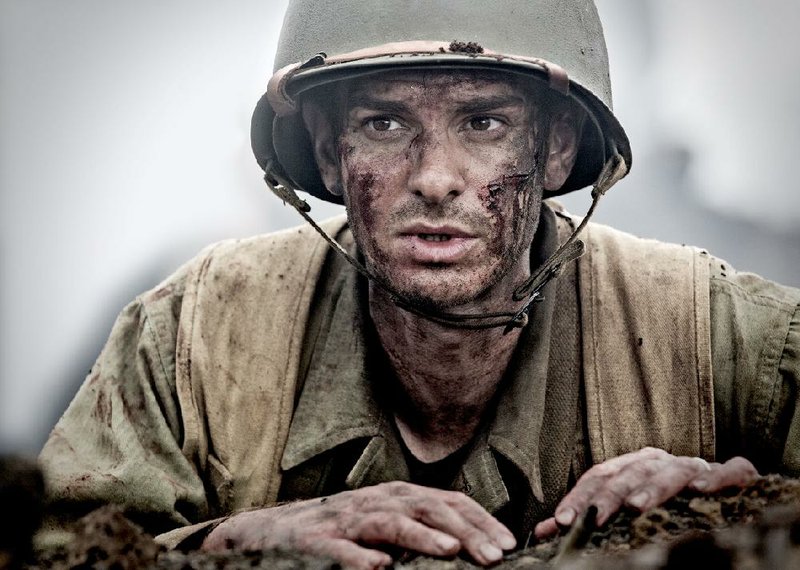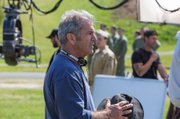You can say a lot of things about Mel Gibson, many of them disparaging, but as a filmmaker, he certainly plays to his convictions, as peculiar a combination as they may be. Like Woody Allen consistently making films about older men falling in love with younger women or Wes Anderson's punchy, twee aesthetic, Gibson's films seem to reflect his essence, and the confusing jumble of beliefs and contradictions that make up his psyche.
Returning from the shallow grave of outspoken Hollywood bigots -- where he has lain low these many years since his epic fall from grace -- he has at last returned to the director's chair a decade after his last film, Apocalypto. His new production Hacksaw Ridge, based on the true story of Desmond T. Doss, a conscientious objector who saved many lives in a brutal World War II battle, could not possibly be more true to his chaotic spirit.
Hacksaw Ridge
80 Cast: Andrew Garfield, Sam Worthington, Luke Bracey, Teresa Palmer, Hugo Weaving, Rachel Griffiths, Vince Vaughn, Richard Roxburgh, Nathaniel Buzolic, Luke Pegler, Ben Mingay, Nico Cortez, Ryan Corr, Jacob Warner
Director: Mel Gibson
Rating: R, for intense prolonged realistically graphic sequences of war violence including grisly bloody images
Running time: 2 hours, 11 minutes
The film opens with scenes of war carnage, bodies being tossed limp in the air by repeated bomb blasts, waves of bullets slicing through young soldiers like streaking wasps, the camera slowly crawling over piles of bodies, blood, entrails and torn-off limbs. Over this scene of violent cataclysm, we hear a young man's voice calmly recite from Isaiah 40:31 "Yet those who wait for the Lord will gain new strength; They will mount up with wings like eagles, They will run and not get tired, They will walk and not become weary."
The voice belongs to Doss (Andrew Garfield), a sweet-faced kid from Virginia whose religious beliefs as a Seventh-day Adventist do not dissuade him from enlisting in the Army to perform his patriotic duty, even as he refuses to ever so much as pick up a firearm. Instead, he joins specifically to be a noncombat medic but is sent by mistake to a rifle infantry unit, where his strong ethical beliefs clash mightily with his superiors, Sgt. Howell (Vince Vaughn) and Capt. Glover (Sam Worthington), who try to drum the poor kid out and back home on a rail, only to be legally outmaneuvered and forced to accept him into their fold.
We then move away from the day-to-day grind of boot camp to the film's signature set-piece, the horrific battle of the Ridge, wherein waves of infantrymen are tasked to climb up a cargo net draped some 100 feet up a cliff-face, in order to do battle against the Japanese on a torn-apart ridge somewhere on Okinawa. Gibson, who to this point had shown a surprisingly light touch -- especially documenting the ridiculously cute courtship between Desmond and Dorothy (Teresa Palmer), a nurse at a local hospital close to his hometown -- now gets to indulge his continued obsession with bodily damage. We return to the opening scene, with bodies and entrails flying in all directions, giant jets of flame lighting troops on fire, and a horrible hazy smoke blinding everyone to the very real danger all around them.
The case could also be made during the battle scenes that Gibson gets to indulge yet another one of his pet manias, disconcerting prejudice. Throughout these scenes of slaughter, the Japanese (constantly referred to as "Japs" and "Nips") are described as "animals" and shown to be almost phantasm-like, emerging snarling from the mist stabbing and shooting our helpless GIs unceasingly, like an army of the already undead. Notably, as well, Gibson's camera switches back and forth between close-ups of the American troops -- many of whom we recognize from Desmond's company -- getting mowed down by bullets, and longer shots of the American retaliations, knocking out swarms of Japanese soldiers, whose faces remain shadowed, generic, or, more frequently, seen from behind as their bodies collapse into the muck at their feet. They are nameless and faceless, an enemy without individual identity, which makes them that much easier to vilify.
The dramatic climax build-up, however, actually occurs after the first wave of battle, with the Americans now driven back down the cliff face in full retreat, leaving many of their wounded compatriots writhing and alone on the battlefield. Consulting with his God, Desmond determines that he is still needed on the ridge, however, and refuses to climb back down to safety. Instead, he scampers around the smoking rubble all night long in order to find still living soldiers in need of his help, whom he then lowers via a rope back down to the safety of his troop down below. In the course of the night, he saves numerous lives in this fashion, all without ever firing a bullet or killing anyone in the field. It is truly an act of heroism worthy of this exposure, especially as it comes in celebration of an advocate of nonviolence and a vegetarian, whose convictions were so strong he continually risked his own life to live by them.
As commendable as Desmond might be, however, Gibson's filmic treatment of him is endlessly problematic in perfectly Mel fashion. He combines the pious, selfless love of true Christians -- and/or the first Christian -- with his resolute preoccupation with wounds, gore and ultra-violence. That he keeps mining the same material in different forms suggests that he very much wants to have it both ways: preaching the gospel and showing the light, while shining that light on eruptions of blood-soaked miasma, carnage and desiccated body parts. It is, as always, a peculiarly disconcerting mixture, but one that permeates a great deal of his work.
Similar in pace and style to the opening battle sequences in Spielberg's Saving Private Ryan, Gibson's treatment also reveals his limitation as a filmmaker. Spielberg utilized the battle sequences to give the audience a taste of what storming the beaches at Normandy was truly like, in all their terrifying immediacy, in an act of storytelling; Gibson's continued pouring over the blood-soaked effect of close combat doesn't advance the narrative as much as it announces the continued obsessions of its beleaguered progenitor.
MovieStyle on 11/04/2016


